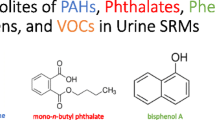Summary
To compare symptoms with urinary metabolite levels, 900 workers from 7 organic solvent-using industries were studied. Urinary metabolites were determined using a high performance liquid chromatograph. Urinary hippuric acid concentrations exceeding the reference value (2.5 g/g creatinine) were found in 78 (8.7%) workers. However, only 3 (0.3%) and 1 (0.1%) of the participants exceeded the reference value for mandelic (0.8 g/g creatinine) and total methylhippuric acid (1.5 g/g creatinine), respectively. The sum of the values of the ratio of measured urinary metabolite concentration to the corresponding ACGIH's biological exposure indices (BEI) [(HA/ BEI of HA + MHA/BEI of MHA + MA/BEI of MA)] exceeded 1.0 in 166 (18.4%) workers. Majority of them were from the footwear manufacturing industry (63/129 or 49.2%). Questionnaire interviews were also administered to determine the prevalence of symptoms while at work (acute symptoms) or within the past 6 months (chronic symptoms). Urinary metabolite levels of individual and mixed solvents were compared with the symptoms of all workers. Analysis using Spearman's rank correlation showed in workers whose urinary hippuric acid exceeded 3.75 g/g creatinine (1.5x BEI), significant correlation between their hippuric acid levels and subjective complaints. Workers whose sum of the values of the ratio of measured urinary metabolite concentration to corresponding BEI exceeded 1.5 were selected and comparing this level with their symptoms, significant correlation was also noted in some complaints.
Similar content being viewed by others
References
American Conference of Governmental Industrial Hygienists (1990) Threshold limit values and biological exposure indices for 1990–1991. ACGIH, Cincinnati
Arlien-Soborg P (1992) Solvent Neurotoxicity. CRC Press, Florida
Edling C, Ekberg K, Ahlborg Jr. G, Alexandersson R, Barregard L, Ekenvall L, Nilsson L, Svenson B G (1990) Long term follow up of workers exposed to solvents. Br J Ind Med 47:75–82
Ikeda M (1988) Multiple Exposure to Chemicals. Regulat Toxicol Pharmacol 8:414–421
Inoue T, Takeuchi Y, Hisanaga N, Ono Y, Iwata M, Ogata M, Saito K, Sakurai H, Hara I, Matsushita T, lkeda M (1983) A nationwide survey in organic solvents components in various solvent products: Part I Homogeneous products such as thinners, degreasers, and reagents. Ind Health 21:175–183
International Labour Organisation (1988) Yearbook of Labour Statistics 1988. International Labour Office 48:554
Ogata M, Tomokuni K, Takatsuka Y (1970) Urinary excretion of hippuric acid and m- or p- methyhippuric acid in the urine of persons exposed to vapors of toluene and m- or p- xylene as a test of exposure. Br J Ind Med 27:43–50
Lee BK, Lee SH, Lee KM, Sho KS, Ahn KD, Kim SB, Ukai H, Nakatsuka H, Watanabe T, Ikeda M (1988) Dose-dependent increase in subjective symptom prevalence among toluene-exposed workers. Ind Health 26:11–23.
Miura T, Ikeda M, Osanai H, Suzuki T, Takata T, Nishioka A, Nishikawa S, Nomura S, Fusamura N (1988) Handbook of Occupational Health (In Japanese). Inst Sci Labor, Japan
Madjar V M and Winchester R V (1986) Solvent effects on workers in the paint, adhesive and printing industries. Ann Occup Hyg 30:307–317
Seki Y (1986) Laboratory Methods Specific Medical Examination (In Japanese). Kojinsha, Japan
Van Vliet C, Swaen GMH, Meijers JMM, Slangen J, De Boorder T, Sturmans F (1989) Prenarcotic and neurasthenic symptoms among Dutch workers exposed to organic solvents. Br J Ind Med 46:586–590
WHO/Nordic Council of Ministers Working Group (1985) Chronic Effects of Organic Solvents on the Central Nervous System and Diagnostic Criteria. Environmental health Series, Copenhagen
Author information
Authors and Affiliations
Rights and permissions
About this article
Cite this article
Ma. Cucueco, T.S., Espinosa, N.C., Villanueva, M.B.G. et al. Urinary metabolite levels and symptoms in Filipino workers using organic solvents. Int. Arch Occup Environ Heath 65 (Suppl 1), S167–5170 (1993). https://doi.org/10.1007/BF00381333
Issue Date:
DOI: https://doi.org/10.1007/BF00381333




